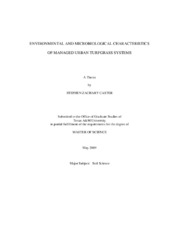| dc.description.abstract | A two-year study was conducted in which soil solution, drainage water, and soil
core samples were taken from three turfgrass test plots and two sports fields, located on
the Texas A&M University campus. The goal was to determine concentrations of
organic nutrients moving through the soil profile, as well as to characterize microbial
numbers and community composition under three turfgrasses on a native soil (Boonville
fine sandy loam) and two sports fields with highly engineered sand-based root zones.
The turfgrasses were Bermudagrass (Cynodon dactylon (L.) Pers), Zoysiagrass (Zoysia
japonica Steud.), and St. Augustinegrass (Stenotaphrum secundatum (Walt.) Kuntze).
The sports fields (soccer/softball) were sodded with 419 turf-type Bermudagrass and
over-seeded in winter with ryegrass (Lolium perenne (L.)). Soil solutions (turfgrass
plots) or drainage water (sports fields) were analyzed for dissolved organic carbon
(DOC) with a total organic carbon (TOC) analyzer; for dissolved organic nitrogen
(DON) using a persulfate oxidation method; and for dissolved organic phosphorus
(DOP) with an ascorbic acid method. Microbial populations were characterized with respect to bacterial and fungal
numbers by standard plate counts; carbon substrate utilization (CSU) with Biolog�
GN2 plates; and community composition with a fatty acid methyl ester (FAME)
protocol.
Nutrients in soil solutions varied between individual plots, showing seasonal
trends in DOC and DON, with peak concentrations of DOC (135.3mg L-1) and DON
(43.5mg L-1) found during late summer. DOP levels were highly variable among the
turf plots with a peak during early fall (11.6mg L-1). Drainage water samples
demonstrated similar seasonal trends in DOC and DON, with peak levels of DOC
(118.4mg L-1) and DON (58.5mg L-1) also occurring during late summer.
Concentrations of DOP were markedly lower in the drainage water than in the soil
solution, with a peak in early fall (8.3mg L-1).
Bacteria and fungi showed some minor seasonal changes throughout the year, but
were not significantly different. CSU profiles demonstrated a high degree of overlap
across all sites, indicating comparable metabolic capacity regardless of the type of turf.
The FAME results identified differences in the microbial communities under the turf
plots and sports fields, as evidenced by the high degree of separation observed between
the FAME profiles from the Boonville soil and sand-based root zones. When FAME
profiles were compared over time, there also appeared to be little overlap between the
individual sampling dates at all locations, which may be an indicator of seasonal
influence. | en |


